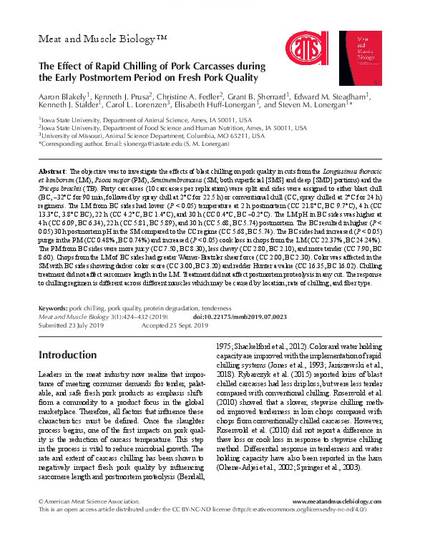
The objective was to investigate the effects of blast chilling on pork quality in cuts from the Longissimus thoracic et lumborum (LM), Psoas major (PM), Semimembranosus (SM; both superficial [SMS] and deep [SMD] portions) and the Triceps brachii (TB). Forty carcasses (10 carcasses per replication) were split and sides were assigned to either blast chill (BC, –32°C for 90 min, followed by spray chill at 2°C for 22.5 h) or conventional chill (CC, spray chilled at 2°C for 24 h) regimens. The LM from BC sides had lower (P < 0.05) temperature at 2 h postmortem (CC 21.8°C, BC 9.7°C), 4 h (CC 13.3°C, 3.8°C BC), 22 h (CC 4.2°C, BC 1.4°C), and 30 h (CC 0.4°C, BC –0.2°C). The LM pH in BC sides was higher at 4 h (CC 6.09, BC 6.34), 22 h (CC 5.81, BC 5.89), and 30 h (CC 5.68, BC 5.74) postmortem. The BC resulted in higher (P < 0.05) 30 h postmortem pH in the SM compared to the CC regime (CC 5.68, BC 5.74). The BC sides had increased (P < 0.05) purge in the PM (CC 0.48%, BC 0.74%) and increased (P < 0.05) cook loss in chops from the LM (CC 22.37%, BC 24.24%). The PM from BC sides were more juicy (CC 7.50, BC 8.30), less chewy (CC 2.80, BC 2.10), and more tender (CC 7.90, BC 8.60). Chops from the LM of BC sides had greater Warner-Bratzler shear force (CC 2.00, BC 2.30). Color was affected in the SM with BC sides showing darker color score (CC 3.00, BC 3.20) and redder Hunter a value (CC 16.35, BC 16.02). Chilling treatment did not affect sarcomere length in the LM. Treatment did not affect postmortem proteolysis in any cut. The response to chilling regimen is different across different muscles which may be caused by location, rate of chilling, and fiber type.
Available at: http://works.bepress.com/kenneth_stalder/235/

This article is published as Blakely, A., K. J. Prusa, C. A. Fedler, G. B. Sherrard, E. M. Steadham, K. J. Stalder, C. L. Lorenzen, E. Huff-Lonergan, and S. M. Lonergan. 2019. The Effect of Rapid Chilling of Pork Carcasses during the Early Postmortem Period on Fresh Pork Quality. Meat and Muscle Biology 3:424-432. doi: 10.22175/mmb2019.07.0023.